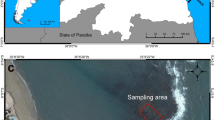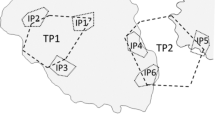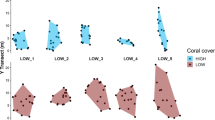Abstract
Territorial behaviour is a conspicuous determinant of social organisation in many reef fishes including parrotfishes. Most parrotfish studies in the Caribbean have focused on the species Scarus iserti and Sparisoma viride over limited ranges of reef habitat. By contrast, our study has included all common parrotfishes in Belize (Sc. iserti, Sp. viride, Sparisoma aurofrenatum, Sparisoma chrysopterum, and Sparisoma rubripinne) at three sites with different physical and biotic conditions and a wide range of fish densities. Density in Sc. iserti was strongly positively correlated to substrate rugosity. In contrast, densities of Sp. chrysopterum and Sp. rubripinne were unrelated to rugosity and territories were large. Territory size was smallest in Sc. iserti (mean areas at the three sites ranged from 41 to 120 m2) and largest in Sp. rubripinne (ranged from 168 to 1400 m2). All species except Sp. chrysopterum exhibited significantly larger territories where density was low as suggested by territory theory. Territory size decreased rapidly with increasing density of competitors. Patterns of harem size differed between two groups of parrotfishes. (1) Sc. iserti, Sp. viride, and Sp. aurofrenatum exhibited an expected positive correlation with territory size. (2) Harem size was smaller in Sp. rubripinne and Sp. chrysopterum, and showed no spatial pattern. Aggression in Sp. viride and Sc. iserti was directed entirely towards intraspecifics and positively density dependent. Interspecific interactions accounted for only 10% of observations and were recorded exclusively whilst following Sp. chrysopterum, Sp. rubripinne, and, to a lesser extent, Sp. aurofrenatum. A meta analysis of species interactions suggested that intraspecific interactions were most common where overall fish density was greatest and conversely, interspecific interactions occurred more often at lower densities. This may suggest that the economic defensibility of territories is largely confined to intraspecifics where density is greatest. Most (62%) of the interspecific interactions comprised Sp. rubripinne chasing the smaller species Sp. chrysopterum, suggesting that territorial behaviour has at least some non-reproductive origin and may therefore be associated with either food or shelter. It is feasible that at such low population densities, it is economically feasible for Sp. rubripinne to defend against intraspecifics and Sp. chrysopterum. Social behaviour in Sp. chrysopterum and Sp. rubripinne, and to a lesser extent Sp. aurofrenatum, differs to that of Sc. iserti and Sp. viride which conform to existing theories of social behaviour in reef fish.
Similar content being viewed by others
References cited
Barlow, G.W. 1975. On the sociobiology of four Puerto Rican parrotfishes (Scaridae). Mar. Biol. 33: 281–293.
Bellwood, D.R. & J.H. Choat. 1990. A functional analysis of grazing in parrotfishes (family Scaridae): the ecological implications. Env. Biol. Fish. 28: 189–214.
Brawley, S.H. & W.H. Adey. 1977. Territorial behaviour of threespot damselfish (Eupomecentrus planifrons) increases reef algal biomass and productivity. Env. Biol. Fish. 2: 45–51.
Brock, R.E. 1979. An experimental study on the effects of grazing by parrotfishes and role of refuges in benthic community structures. Mar. Biol. 51: 381–388.
Brown, J.L. 1964. The evolution of diversity in avian territorial systems. Wilson Bulletin 76: 160–169.
Bruggemann, J.H., M.W.M. Kuyper & A.M. Breeman. 1994a. Comparative analysis of foraging and habitat use by the sympatric Caribbean parrotfish Scarus vetula and Sparisoma viride. Mar. Ecol. Prog. Ser. 112: 51–66.
Bruggemann, J.H., M.J.H. van Oppen & A.M. Breeman. 1994b. Foraging by the stoplight parrotfish, Sparisoma viride. I. Food selection in different, socially determined habitats. Mar. Ecol. Prog. Ser. 106: 41–55.
Buckman, N.S. & J.C. Ogden. 1973. Territorial behaviour of the striped parrotfish Scarus croicensis (Bloch Scaridae). Ecology 54: 1377–1382.
Carpenter, R.C. 1986. Partitioning herbivory and its effects on coral reef algal communities. Ecol. Monogr. 56: 345–363.
Choat, J.H. & D.R. Bellwood. 1985. Interactions amongst herbivorous fishes on a coral reef: influence of spatial variation. Mar. Biol. 89: 221–234.
Clavijo, I.E. 1982. Distribution, reproductive biology, and social structure of the redband parrotfish, Sparisoma aurofrenatum (Valenciennes). Ph.D. Thesis, University of Puerto Rico, Mayaguez. 151 pp.
Clifton, K.E. 1989. Territory sharing by the Caribbean striped parrotfish, Scarus iserti: patterns of resource abundance, group size and behaviour. Ani. Behav. 37: 90–103.
Clifton, K.E. 1990. The cost and benefits of territory sharing for the Caribbean coral reef fish, Scarus iserti. Behav. Ecol. Sociobiol. 26: 139–147.
Davies, N.B. & A.I. Houston. 1984. Territory economics. pp. 148–169. In: J.R. Krebs & N.B. Davies (ed.) Behavioural Ecology, and Evolutionary Approach, Blackwell Scientific, Oxford.
Dubin, R.E. 1981. Social behaviour and ecology of some Caribbean parrotfish (Scaridae). Ph.D. Thesis, University of Alberta, Edmonton.
Ebersole, J.P. 1980. Food density and territory size: an alternate model and a test on the reef fish Eupomacentrus leucostictus. Amer. Nat. 115: 492–509.
Gronell, A.M. 1980. Space utilisation by the cocoa damselfish, Eupomacentrus variabilis (Pisces: Pomacentridae). Bull. Mar. Sci. 30: 237–251.
Hanley, F. 1984. Time-budgeting and foraging strategy of the stoplight parrotfish Sparisoma viride (Bonnaterre), in Jamaica. J. Exp. Mar. Biol. Ecol. 83: 159–177.
Hixon, M.A. & W.N. Brostoff. 1996. Succession and herbivory: effects of differential fish grazing on Hawaiian coral reef algae. Ecol. Monogr. 66: 67–90.
Horn, M.H. 1989. Biology of marine herbivorous fishes. Oceanogr. Mar. Biol. Ann. Rev. 27: 167–272.
Itzkowitz, M. & C.J. Slocum. 1995. Is the amount of algae related to territorial defense and reproductive success in the beaugregory damselfish? Marine Behav. Physiol. 24: 243–250.
Jones, G.P. & M.D. Norman. 1986. Feeding selectivity in relation to territory size in a herbivorous reef fish. Oecologia 68: 549–556.
Kaufman, L.S. 1977. The threespot damselfish: effects on benthic biota of Carribean coral reefs. Proc. 3rd Int. Coral Reef Symp. 1: 559–564.
Kaufmann, J.H. 1983. On the definition and functions of dominance and territoriality. Biol. Rev. 58: 1–20.
Larson, R.J. 1980. Competition, habitat selection, and the bathymetric segregation of two rockfish (Sebastes) species. Ecol. Monogr. 50: 221–239.
Lessios, H.A. 1995. Diadema antillarum 10 years after mass mortality – still rare, despite help from a competitor. Proc. R. Soc. Lond. B 259: 331–337.
Letourneur, Y. 2000. Spatial and temporal variability in territoriality of a tropical benthic damselfish on a coral reef (Réunion Island). Env. Biol. Fish. 57: 377–391.
Lewis, S.M. 1986. The role of herbivorous fishes in the organisation of a Caribbean reef community. Ecol. Monogr. 56: 183–200.
Lewis, S.M. & P.C. Wainwright. 1985. Herbivore abundance and grazing intensity on a Caribbean coral reef. J. Exp. Mar. Biol. Ecol. 87: 215–228.
Lewis, S.M., J.N. Norris & R.B. Searles. 1987. The regulation of morphological plasticity in tropical reef algae by herbivory. Ecology 68: 636–641.
Ma, Z. & R.L. Redmond. 1995. Tau coefficients for accuracy assessment of classification of remote sensing data. Photogr. Eng. Remote Sensing 61: 435–439.
McAfee, S.T. & S.G. Morgan. 1996. Resource use by five sympatric parrotfishes in the San Blas Archipelago, Panama. Mar. Biol. 125: 427–437.
Morrison, D. 1988. Comparing fish and urchin grazing in shallow and deeper coral reef algal communities. Ecology 69: 1367–1382.
Mumby, P.J. 1999. Bleaching and hurricane disturbances to populations of coral recruits in Belize. Mar. Ecol. Prog. Ser. 190: 27–35.
Muñoz, R.C. 1996. Social behaviour and foraging ecology of Sparisoma aurofrenatum and S. chrysopterum (Pisces: Scaridae) in the Florida Keys. M.Sc. Thesis, University of South Florida, Tampa.
Noble, G.K. 1939. The role of dominance in the social life of birds. Auk 56: 263–283.
Norman, M.D. & G.P. Jones. 1984. Determinants of territory size in the pomacentrid reef fish, Parma victoriae. Oecologia 61: 60–69.
Nursall, J.R. 1974. Some territorial behaviour atttributes of the surgeonfish Acanthurus lineatus, at Heron Island, Queensland. Copeia 1974: 950–959.
Nursall, J.R. 1977. Territoriality in redlip blennies Ophioblennius atlanticus – Pisces: Blenniidae. J. Zool. (London) 182: 205–223.
Ogden, J.C. & N. Buckman. 1973. Movements, foraging groups, and diurnal migrations of the striped parrotfish Scarus croicensis (Bloch Scaridae). Ecology 54: 589–596.
Overholtzer, K.L. & P.J. Motta. 1999. Comparative resource use by juvenile parrotfishes in the Florida Keys. Mar. Ecol. Prog. Ser. 177: 177–187.
Pressley, P.H. 1981. Pair formation and joint territoriality in a simultaneous hermaphrodite – the coral reef fish Serranus tigrinus. Z. Tierpsychol. 56: 33–46.
Randall, J.E. & H.A. Randall. 1963. The spawning and early development of the atlantic parrotfish, Sparisoma rubripinne, with notes on other scarid and labrid fishes. Zoologica 48: 49–60.
Reese, E.S. 1978. The study of space-related behaviour in aquatic animals: special problems and selected examples. pp. 347–374. In: E.S. Reese & F.J. Lighter (ed.) Contrasts in Behaviour, John Wiley, New York.
Robertson, D.R. & N.V.C. Polunin. 1981. Coexistence: symbiotic sharing of feeding territories and algal good by some coral reef fishes from theWestern Indian Ocean. Mar. Biol. 62: 185–195.
Robertson, D.R. & R.R. Warner. 1978. Sexual patterns in the labroid fishes of the Western Caribbean. II. The parrotfishes (Scaridae). Smithsonian Contr. Zool. 255: 1–26.
Sale, P.F. 1971. Extremely limited home range in a coral reef fish, Dascyllus aruanus (Pisces; Pomacentridae). Copeia 1971: 324–327.
Schoener, T.W. 1981. An empirically based estimate of home range. Theor. Pop. Biol. 20: 281–325.
Sokal, R.R. & F.J. Rohlf. 1995. Biometry, 3rd edn. W.H. Freeman, New York. 887 pp.
Thresher, R.E. 1976. Field analysis of the territoriality of the threespot damselfish, Eupomacentrus planifrons (Pomacentridae). Copeia 1976: 266–276.
Tolimieri, N. 1998. Effects of substrata, resident conspecifics and damselfish on the settlement and recruitment of the stoplight parrotfish, Sparisoma viride. Env. Biol. Fish. 53: 393–404.
van Rooij, J.M., J.H. Bruggemann, J.J. Videler & A.M. Breeman. 1995. Ontogenetic, social, spatial and seasonal variations in condition of the reef herbivore Sparisoma viride. Mar. Biol. 123: 269–275.
van Rooij, J.M., E. de Jong, F. Vaandrager & J.J. Videler. 1996a. Resource and habitat sharing by the stoplight parrotfish, Sparisoma viride, a Caribbean reef herbivore. Env. Biol. Fish. 47: 81–91.
van Rooij, J.M., J.P. Kok & J.J. Videler. 1996b. Local variability in population structure and density of the protogynous reef herbivore Sparisoma viride. Env. Biol. Fish. 47: 65–80.
van Rooij, J.M., F.J. Kroon & J.J. Videler. 1996c. The social and mating system of the herbivorous reef fish Sparisoma viride: one-male vs. multi-male groups. Env. Biol. Fish. 47: 353–378.
Warner, R.R. & S.G. Hoffman. 1980. Population density and the economics of territorial defense in a coral reef fish. Ecology 61: 772–780.
Author information
Authors and Affiliations
Rights and permissions
About this article
Cite this article
Mumby, P.J., Wabnitz, C.C. Spatial Patterns of Aggression, Territory Size, and Harem Size in Five Sympatric Caribbean Parrotfish Species. Environmental Biology of Fishes 63, 265–279 (2002). https://doi.org/10.1023/A:1014359403167
Issue Date:
DOI: https://doi.org/10.1023/A:1014359403167




